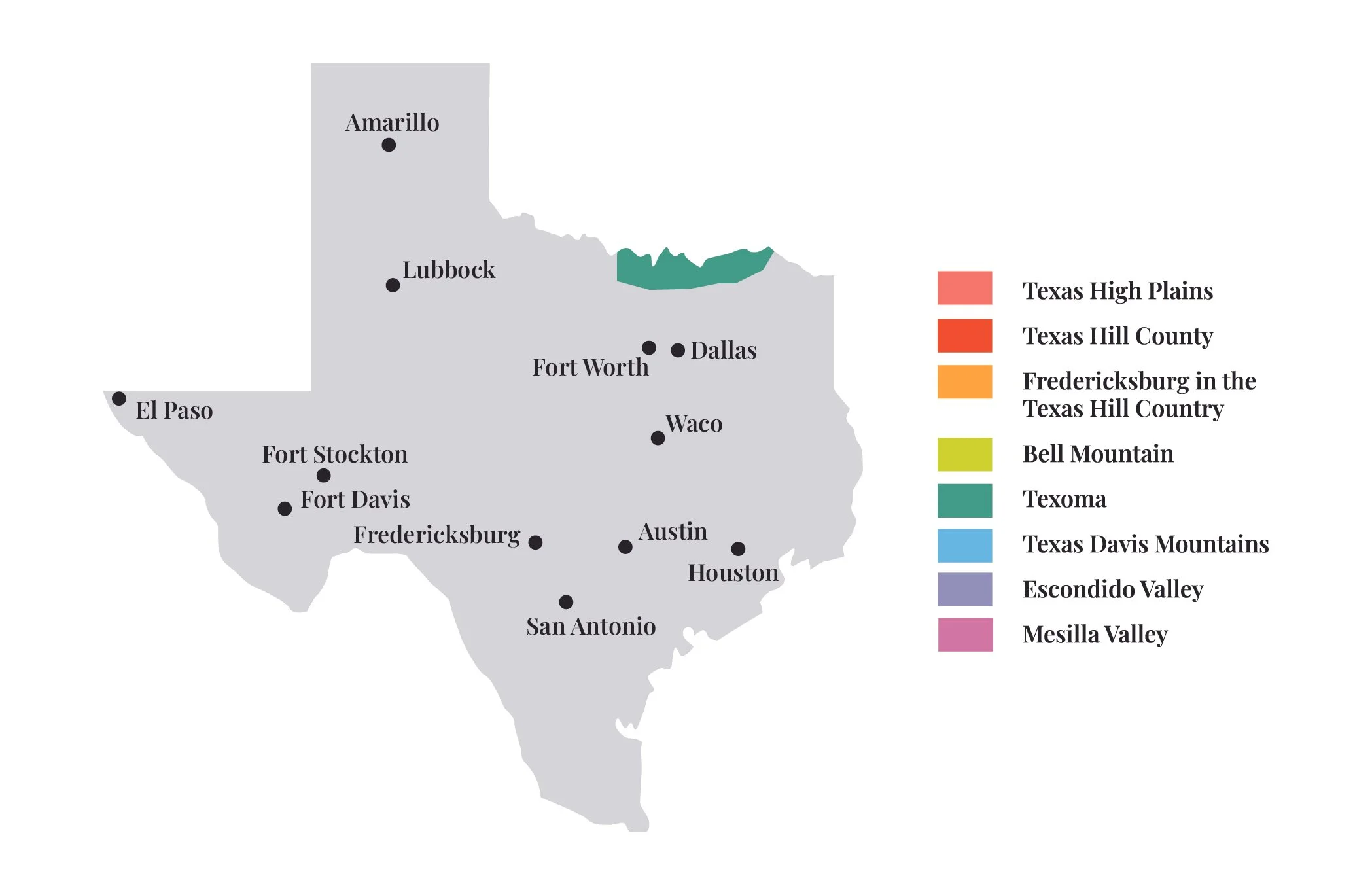Texoma AVA:
Lake‑Cooled Vines on the Red River Border
Authorized in 2005, the Texoma American Viticultural Area (AVA) hugs 200 miles of the Red River along the Texas–Oklahoma border, just north of Dallas–Fort Worth. Encompassing roughly 3,650 square miles (2.3 million acres) across Grayson, Cooke, and Fannin counties, Texoma is where the late pioneering viticulturist Thomas Munson developed the phylloxera‑resistant rootstocks that saved European vineyards in the 19th century. For beginning wine students, Texoma offers a case study in how lake moderation, limestone‑rich soils, and humid‑subtropical weather shape grape choices that can withstand Texas heat and Pierce’s disease.
Location & Landscape
The AVA fans out from the shores of 89,000‑acre Lake Texoma, rising southward into gentle Prairie and Cross‑Timbers hills. Elevations run 600–1,000 feet—low for Texas—but constant breezes off the lake and Red River moderate extremes. Soils are shallow, calcareous clay loams over soft Cretaceous limestone and marl, dotted with outcrops of red sandy loam nearer the river. Native post oak and blackjack forests provide natural windbreaks and erosion control.
Climate: Humid‑Subtropical with a Lake Effect
· Rainfall: 36–40 inches annually—the wettest of Texas AVAs—spread across spring thunderstorms and autumn fronts.
· Temperature: Summer highs reach mid‑90s °F, yet Lake Texoma’s thermal mass tempers peak heat and reduces spring frost near the shoreline.
· Humidity: Higher than High Plains; vigilant canopy management and fungicide schedules combat downy mildew.
· Storms: Tornadic squall lines can deliver hail; nylon netting and multi‑tier trellises reduce damage.
Bottom line: Texoma’s lake effect narrows diurnal swing (≈ 15 °F), so growers rely on disease‑resistant cultivars and breeze‑friendly trellis designs to maintain fruit integrity.
Terroir: Limestone Marl & Red Sandy Loams
Underlying Austin Chalk limestone fractures easily, offering excellent drainage despite high rainfall. High calcium content (pH 7.4–8.1) helps buffer acids in grapes like Viognier and Blanc du Bois. Nearer the Red River, iron‑rich sandy loams warm quickly in spring, aiding early budbreak but increasing Pierce’s disease risk; growers graft onto tolerant rootstocks and favor French‑American hybrids. Together, chalky and sandy soils produce whites with bright citrus lift and reds featuring soft tannins and savory spice.
Signature Grapes & Why They Thrive
Viognier - Thrives in limestone clay; lake breezes reduce rot on tight clusters, preserving apricot perfume.
Blanc du Bois - Hybrid immune to Pierce’s disease; tropical citrus profile excels in humid summers.
Black Spanish (Lenoir) - Naturally disease‑resistant red; delivers blackberry‑sage notes despite humidity.
Tempranillo - Thick skins handle heat; early ripening avoids September rain events.
Cabernet Franc - Earlier ripener than Cabernet Sauvignon; limestone adds graphite and herb lift.
Chambourcin - French‑American hybrid with stout mildew resistance; produces plush cherry‑plum reds.
Known for disease‑tolerant hybrids alongside Mediterranean vinifera such as Tempranillo and Viognier—varieties that balance flavor, market appeal, and local resilience.
Interesting Facts
· Lake Breeze Index: Vineyards within 5 miles of Lake Texoma report 4–5 °F cooler afternoon canopy temps versus inland blocks.
· Wine & Water Sports: Many tasting rooms sit near marinas, pairing sunset sails with flights of Viognier and fish‑friendly Blanc du Bois.
Visiting & Nearby Cities
• Denison & Sherman – 10 miles east; birthplace of T.V. Munson, Eisenhower Birthplace State Historic Site
• Gainesville – 25 miles west; German festivals and zoo safari park
• Dallas–Fort Worth – 60–75 miles south; major airport and urban tasting rooms pouring Texoma fruit
Route suggestion: Start at Munson Memorial Vineyard, follow Hwy 82 to west‑side wineries, then finish with lake‑view sunsets at Preston Peninsula.
Putting It All Together
Texoma AVA shows that combating disease pressure is as crucial as heat management in humid parts of Texas. Studying this region highlights rootstock innovation, hybrid utilization, and micro‑climate tactics such as lake breezes—all valuable lessons for future viticulturists.
· Disease‑tolerant hybrids can craft quality wine—blind‑taste Blanc du Bois against unoaked Chardonnay to compare citrus‑mineral profiles.
· Lake effect smooths extremes—note softer tannins in Texoma Tempranillo versus High Plains renditions.
Next time you enjoy a chilled glass of Texoma Viognier brimming with peach and honeysuckle, picture Lake Texoma’s shimmering waters deflecting heat and drenching vines in sunset breezes.

